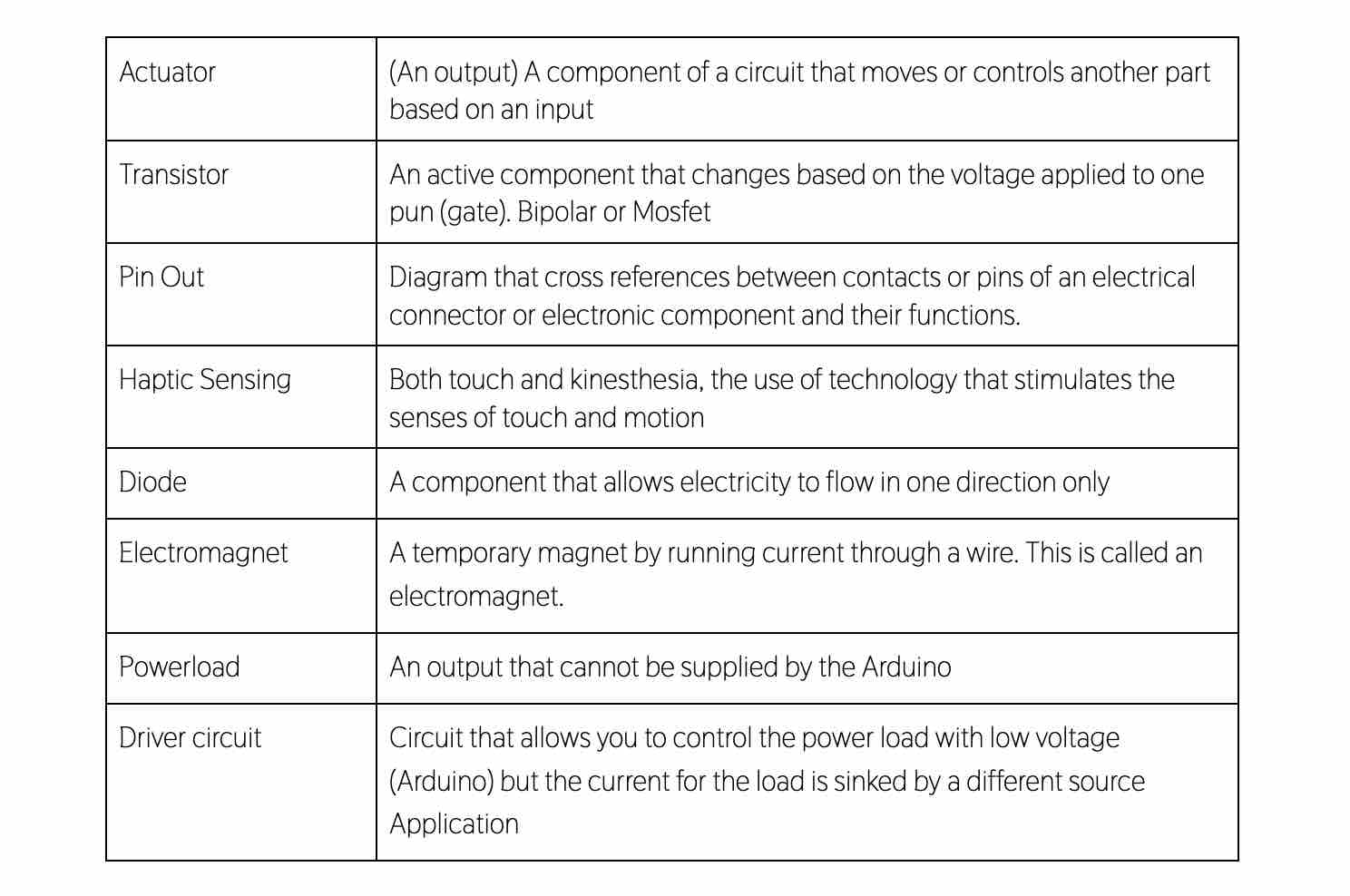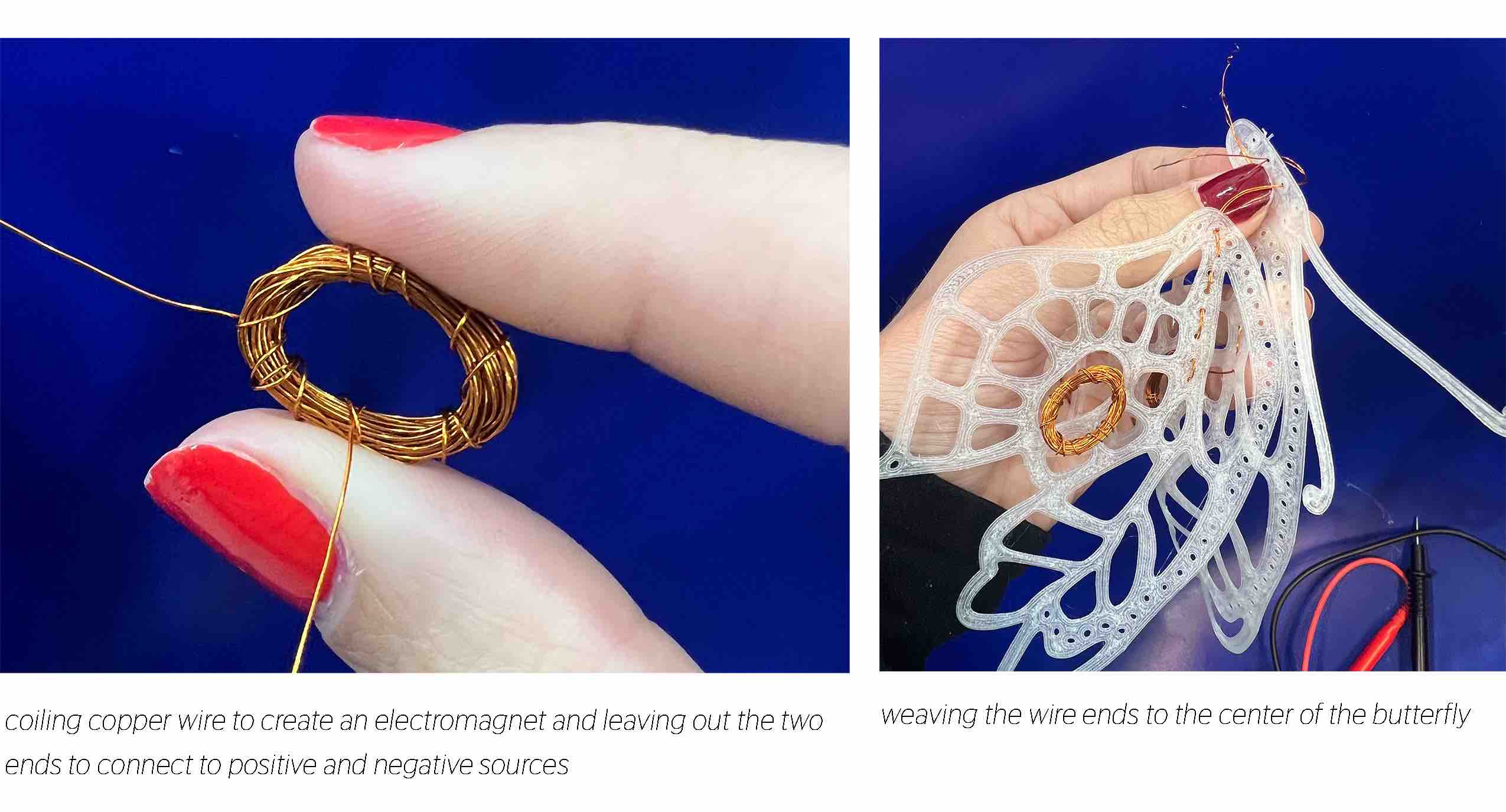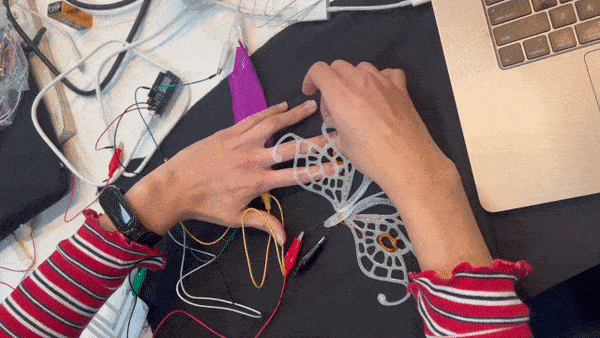8. Wearables¶
INDEX IMAGE ~ Electromagnetic Field - Dynamic Horn Torus
Research and Lecture¶
This week we are expanding on our E-textiles knowledge and taking our circuits to the next level using actuators. As Liza Stark says, there are certain factors to take into consideration with more advanced wearables: durability, wearability, washability (does it have removable parts?), power source (rechargeable? battery?), circuit layout, visibility, privacy (encryption, protection) and of course, sustainability. We are introduced to the idea of wearable technology as a second skin, something that increases our sensing capability in collecting information from our bodies and environments then transforming it into data.
 We are using a transistor called MOSFET. This basically functions as a door, regulating / controling current or voltage flow, amplifying and generating them, and acting as a switch/gate for them.
We are using a transistor called MOSFET. This basically functions as a door, regulating / controling current or voltage flow, amplifying and generating them, and acting as a switch/gate for them.
 Here my paper driver circut set up with a MOSFET:
Here my paper driver circut set up with a MOSFET:

General Materials / Tools¶

We are woking with actuators in different catagories of light, movement, heat and sound. Here is a bit explained about each catagory and examples of possible outputs:
 Lights can be used to create beautiful visual outputs.
Examples: Leds, Neopixels, Fiber optic cables
Lights can be used to create beautiful visual outputs.
Examples: Leds, Neopixels, Fiber optic cables
Materials / Tools¶


Movement such as folding, curling, smocking, flapping, vibrating can be achived by playing with attraction, repulsion and shape memory materials.
Examples: Flip dots, Shape memory alloys, Vibrating motors and haptics
Materials / Tools¶

TIPS
- be careful with wires, use hot glue to secure them and do not pull hard
 Another example of visual outputs are those that are heat sensitive. Thermochromia is the ability to change color with heat. There are often two ways this can happen: Leco dyes or liquid crystals. A leuco dye is an organic carbon based dye which can switch between two chemical forms; one of which is colorless. Reversible transformations can be caused by heat, light or pH. Liquid Crystals are usually used in computer or cellphone displays, and is also what makes 'mood rings' temperature controlled jewelry function. (source)
Another example of visual outputs are those that are heat sensitive. Thermochromia is the ability to change color with heat. There are often two ways this can happen: Leco dyes or liquid crystals. A leuco dye is an organic carbon based dye which can switch between two chemical forms; one of which is colorless. Reversible transformations can be caused by heat, light or pH. Liquid Crystals are usually used in computer or cellphone displays, and is also what makes 'mood rings' temperature controlled jewelry function. (source)
 More information about thermochromia here
More information about thermochromia here
Materials / Tools¶

 Sound waves are vibrating particles that knock into other particles causing them to vibrate. We hear sound because the vibrations in the air cause our ear drums to vibrate. This vibration is converted into signals which travel down a nerve to the brain.
Examples: Speakers
Sound waves are vibrating particles that knock into other particles causing them to vibrate. We hear sound because the vibrations in the air cause our ear drums to vibrate. This vibration is converted into signals which travel down a nerve to the brain.
Examples: Speakers
Materials / Tools¶

Making a Speaker¶
When you connect an audio signal to an electromagent (coil) it creates a magnetic field that fluctuates based on the frequescies of the audio signal. Placing a strong magnet near the field will make it attract and repel. This membrane then moves the air around it making sound!

Options:
1: generate a sound with Arduino on the speaker
2: play the music from your device (iphone/computer) on the speaker
3: play audio tracks from a SDcard on the speaker
Power Load is 4Ohm / 8Ohm
TIPS
- get more vibrations from many dense lines in the coil
- very porous fabrics wont make sound because it won’t vibrate the air well (because it is going through the holes) use stiff and non breathable fabric
References & Inspiration¶
These dynamic thermochromic tapestries by Maggie Orth are inspiring to me.
 Cameron Hughes has amazing examples of moving clothing. His designs have been featured in music videos, drag performances and other celebrity events because of their thatrical nature. It is inspiring to see how he hides and organizes all of the wires and electrical componants. The pieces never look too bulky or heavy.
Cameron Hughes has amazing examples of moving clothing. His designs have been featured in music videos, drag performances and other celebrity events because of their thatrical nature. It is inspiring to see how he hides and organizes all of the wires and electrical componants. The pieces never look too bulky or heavy.
@cameronhughes It’s finally done here’s how I assembled it. #fashionindustry #kineticsculpture #fashiontech ♬ Forever - Labrinth
Arduino Coding¶
Process and Workflow¶
Fluttering Wings Sample¶
Concept and Sketches¶
After seeing this exapmle of a flapping motion made with the combination of an electromagnetic coil and a permanent magnet I had the idea to use a similar set up with two butterfly wings.

 I took some inspiration from art nouveau / modernismo styles and started designing wings to 3d print. I sketched out a few possibilities, taking into consideration where the coil would sit and the lightness of the wings to allow movement.
I took some inspiration from art nouveau / modernismo styles and started designing wings to 3d print. I sketched out a few possibilities, taking into consideration where the coil would sit and the lightness of the wings to allow movement.

Making¶
I started sketching thinking I would make an offset of the line but it was hard to work that way and make a logical 3d print so I adapted the sketch in Rhino, taking the ouline and making closed curves that would be like holes in the wing. I used these steps to make it a surface and extrude:
- Select the outline and Make surface from planar curves
- Select all of the inner curves and Make holes
- Extrude the surface in Z direction 0.6
- Export as stl

Then I opened the stl in Cura at the 3d printing computer. I used these settings to prepare the Print:

 Here is the final print and then I moved on to assembly.
Here is the final print and then I moved on to assembly.

I coiled a copper wire into a tight loop to create an electromagnet, then I passed the wires through the holes in the printed wing. I used thread to secure the coil to the wing better. I sewed the magnet into the fabric and attached the center tip of the wings to the fabric as well so they would hold and the flap will be more controlled.
 Then I tested the wing with a 9v battery and magnet to make sure it would function and it did!
Then I tested the wing with a 9v battery and magnet to make sure it would function and it did!

We build a circuit connecting a basic press sensor, so when the fabric was pressed the wing would flap. Following Emma's circuit example with an actuator, driver circuit, sensor and arduino (feather in my case) with a usb power source.


Code for sensor circuit¶
#include <Arduino.h>
#include <analogWrite.h>
int digital_sensor_pin = A5; //change the pin, where the sensor is connected?
int digital_sensor_value = 0; //variable in which we save the sensor voltage
int led_pin = 13; //change the pin of the Led
void setup() {
// put your setup code here, to run once:
pinMode(digital_sensor_pin, INPUT_PULLUP); //initialize the sensor pin
pinMode(led_pin, OUTPUT); //initialize led pin
Serial.begin(9600);
}
void loop() {
digital_sensor_value = digitalRead(digital_sensor_pin); //read the Voltage at pin sensor
//if the sw is pressed, then the led turns on
//otherwise (else) (the sw in not pressed), then the led turns off
//status 1 (HIGH) ==> 5V (switch is not pressed)
//status 0 (LOW) ==> 0V (switch is pressed)
// check if the pushbutton is pressed.
if(digital_sensor_value == LOW){ //If it is pressed
digitalWrite(led_pin, HIGH); // turn the LED on
} else { //If it is NOT pressed
digitalWrite(led_pin, LOW); // turn the LED on by setting the voltage to 5V
}
}
Final Results¶

Thermochromic 'Mood Ring' Test¶
Cholesteric Liquid Crystals in Living Matter¶
This article describes a bit about thermochromia from liquic crystals in nature.
"Liquid crystals play an important role in biology because the combination of order and mobility is a basic requirement for self-organisation and structure formation in living systems. Cholesteric structures can be found in bacteriophages, archaea, eukaryotes, bacterial nucleoids, chromosomes of unicellular algae, sperm nuclei of many vertebrates, cuticles of crustaceans and insects, bone, tendon, cornea, fish scales and scutes, cuttlebone and squid pens, plant cell walls, virus suspensions, silk produced by spiders and silkworms, and arterial wall lesions. The roles and functions of biological cholesteric liquid crystals include maximisation of packing efficiency, morphogenesis, mechanical stability, optical information, radiation protection and evolution pressure."

Concept and Sketches¶
Since I often work with natural color, I am very interested in the possibilities thermochromic materials. Olivia and Emma are experimenting with the inks we have in the lab with fabric this week so I wanted to try something else. I went out looking for some mood ring beads or jewelry to incoorperate into a circuit. I found a few little items at Claire's the kids accessory store.

Making¶


I made a swatch with different conductive materials and tested how the mood ring would interact using the same amount of voltage each time.
Final Results¶

Playtronica Touch Me¶
TouchMe is an electronic device (MIDI controller) that allows you to make music using your computer, tablet, smartphone, or other music hardware. Learn more with this tutorial. The basic directions and functions are these:
- Connect the device to your laptop USB.
- Find sounds to play on the synth library
- Notes change according to the area of touch and intensity. If you apply more pressure the pitch will be higher.
- Alligator clips can connect the Touch Me to any conductive material - instead of having to touch the copper plates on the device, you will have to touch whatever object or material you’ve connected to it.
Playtronica worked with Side Project to create an exhibition in Palais de Tokyo for Paris fashion week. By walking on a metal strip and touching conductive garments, people in the exhibit lock an electrical chain and fill the space with sound.

I embroidered a vintage corset with conductive thread, connected two alligator clips to the touch me controller and pinned it on the corset. Of course this is not a functional or wearable prototype yet because its connected by wire to my computer and the touch me is bulky to wear but it helped my understanding of conductive materials, completing circuits and a very brief introduction to synths and music production.
I used the platform Midi City testing out different sounds and ended up using string ensamble 2 for the video.

